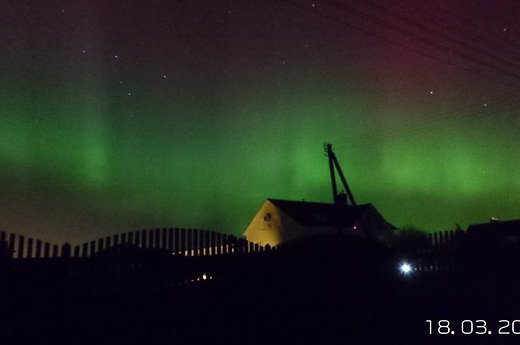
Solar eclipse in Lithuania (Griškabūdis Gymnasium)
About spectrum from Lithuania (Griškabūdis Gymnasium)
From Lithuania ( Griškabūdis Gymnasium)

Rainbows, photosynthesis,sunset, northern lights, natural phenomena and their observation, photos, videos of students' comments about these phenomena
What color is sunshine? When we see the light of the sun streaming through the windows, it appears colorless.
Even though we can’t see it, this “white” light is actually made up of many different colors of light. Each of these colors has a different wavelength.
In 1666, the famous scientist Isaac Newton discovered that if sunlight passed through a triangular piece of glass called a “prism,” the white light would split into a band of colors. This band of colors was made up of red, orange, yellow, green, blue, indigo and violet light.
These are the colors of the rainbow in order. Some people remember them by the name ROY G. BIV.
The “birth” of a rainbow after a rainstorm works in a similar way. After it rains, the air in the atmosphere is filled with raindrops.
Each raindrop acts like a tiny prism. If sunlight passes through raindrops at just the right angle, the light is split into an arc of colors with red on the outside of the band and violet on the inside.
The most brilliant rainbow displays occur when part of the sky is still dark with rainclouds and the viewer is in a sunny spot facing the sun. This creates a very bright and vivid rainbow against the darkend backgroup.
Sometimes it’s possible to see a second arc or “double rainbow.” This is caused by a double reflection of sunlight inside the raindrops. The double reflection causes the colors of a second rainbow to arrange in the opposite order of the colors on a primary arc.
Secondary rainbows are fainter than primary rainbows for two reasons. First, the double reflection allows more light to escape. Second, a double rainbow arcs above the primary rainbow, which means it is spread out over a greater area of sky.
If you’re hoping to find a pot of gold at the end of the rainbow, you may be disappointed to find out there is no real end of the rainbow. This is because rainbows do not actually exist in a particular location in the sky. A rainbow’s position depends on the location of the observer and the position of the sun.
What color is sunshine? When we see the light of the sun streaming through the windows, it appears colorless.
Even though we can’t see it, this “white” light is actually made up of many different colors of light. Each of these colors has a different wavelength.
In 1666, the famous scientist Isaac Newton discovered that if sunlight passed through a triangular piece of glass called a “prism,” the white light would split into a band of colors. This band of colors was made up of red, orange, yellow, green, blue, indigo and violet light.
These are the colors of the rainbow in order. Some people remember them by the name ROY G. BIV.
The “birth” of a rainbow after a rainstorm works in a similar way. After it rains, the air in the atmosphere is filled with raindrops.
Each raindrop acts like a tiny prism. If sunlight passes through raindrops at just the right angle, the light is split into an arc of colors with red on the outside of the band and violet on the inside.
The most brilliant rainbow displays occur when part of the sky is still dark with rainclouds and the viewer is in a sunny spot facing the sun. This creates a very bright and vivid rainbow against the darkened backgroup.
Sometimes it’s possible to see a second arc or “double rainbow.” This is caused by a double reflection of sunlight inside the raindrops. The double reflection causes the colors of a second rainbow to arrange in the opposite order of the colors on a primary arc.
Secondary rainbows are fainter than primary rainbows for two reasons. First, the double reflection allows more light to escape. Second, a double rainbow arcs above the primary rainbow, which means it is spread out over a greater area of sky.
If you’re hoping to find a pot of gold at the end of the rainbow, you may be disappointed to find out there is no real end of the rainbow. This is because rainbows do not actually exist in a particular location in the sky. A rainbow’s position depends on the location of the observer and the position of the sun.